2018 Lightweight Sportbikes Shootout

Honda CBR500R vs. Kawasaki Ninja 400 vs. KTM RC390
It’s getting to be a bit silly what’s passing for a lightweight sportbike these days. In the beginning, it made sense: You had the Kawasaki Ninja 250. And, well, that was it. It only took twenty-odd years, but the other manufacturers eventually took notice that building small bikes to entice new or returning riders was probably a good thing for the industry, and hence, started building little bikes of their own. Honda came around with the CBR250R…just as the competition upped the ante again. Kawasaki pushed the bar with the Ninja 300, then Honda made a weak attempt to follow suit with the 286cc CBR300R. Yamaha then jumped in the game, shoving displacement rules out the window with its 321cc R3 – but not to be outdone, the brash Austrians (via India) at KTM one-upped all of them with the 373cc RC390.
Today, Kawasaki is throwing convention out the window yet again, shelving the Ninja 300 (at least in the U.S.) and giving us the all-new Ninja 400. So it’s only right we at Motorcycle.com put it up against some worthy contenders. If this idea sounds vaguely familiar to you, it’s because we last put the crop of little bikes (not to be confused with liter bikes – very different) together in 2015 in our Beginner-ish Sportbike Shootout. There we had the CBR300, Ninja 300, RC390, and R3 fighting it out, with the Kawasaki narrowly beating the Yamaha for the top spot.
This time around there’s a CBR and an RC390 to go against the Ninja 400; however, considering the beating the CBR300R took in 2015, we’re bringing in its bigger brother – the CBR500R – to take on Kawi’s 400. As for the KTM, the RC390 has received some updates since we last tested one three years ago. Bigger brakes, revised suspension, and some chassis tweaks have made it a sharper scalpel compared to 2015. KTM says nothing was changed with the engine, but we find this hard to believe. Our 2018 tester makes three more ponies to the wheel than our 2015 model, reaching that point 1,000 revs higher (granted, these were different dynos, but the difference in power and engine speed seems significant). This was reason enough to include it in this test. If you take racing into account, then the KTM vs. Kawasaki comparison becomes even stronger, as the two brands are fighting it out in the World Supersport 300 category, as well as the MotoAmerica Junior Cup series.
Obligatory R3 disclaimer
Before we go any further, we can hear the racing fans shouting in protest because the Yamaha R3 isn’t here. They’ll say it’s also a contender in the little bike racing classes both at home and abroad. To that we say – yes, but rule changes are the reason the R3 is anywhere near the front. Rev limits and weight penalties have been added to the other bikes to help the R3 compete. Here in the real world, the R3 – while a great motorcycle in its own right – is simply outclassed in the power department. Plus, it hasn’t changed since we tested it in 2015, so there was no reason to bring it back.
With that out of the way, let’s describe our testing procedure. It’s quite simple, really: We rode all three bikes on the street, to get a feel for their road manners, and also took them to Weathertech Raceway Laguna Seca (yeah, the name still sounds weird to us, too) to really wring their necks. Joining Yours Truly for the ride was our esteemed John Burns, and our semi-retired-motojournalist-turned-scuba-diver-scientist Tom Roderick.
By the numbers
The showdown between the CBR500R, Ninja 400, and RC390 is a very interesting one. All three make between 42 and 44 horsepower (to the wheel) and are also closely matched in the torque department – the Honda topping out at 28.9 lb-ft, while the Kawasaki and KTM make 24.6 lb-ft and 24.4 lb-ft, respectively. From there, the spec sheet gives us a hint as to how this trio will respond to each other.
A look at suspension components shows us the KTM is the only one here with an inverted fork – a nod to the Austrian’s Ready to Race attitude. Its stanchions are 43mm in diameter, similar to sportbikes with double the engine capacity. The Honda and Kawasaki, meanwhile, make do with traditional 41mm forks; the CBR’s adjustable for spring preload. The KTM’s racer dreams are furthered by the 320mm brake disc paired with the only radial-mount, four-piston caliper here. But where the RC390’s track chops really make itself apparent is in its steering geometry numbers. Its 23.5º rake is the steepest here by a wide margin; combining that with its 88mm trail and 52.8-inch wheelbase – the shortest here – means the RC values nimbleness over stability.
At the other end of the spectrum is Honda’s CBR500R. Its rake is a comparatively lazy 25.5º. With 102mm of trail, coupled with its long 55.5-inch wheelbase, the 500R is the tortoise to the KTM’s hare when it comes to steering manners. Slow, steady, and stable is the name of Honda’s game.
Which puts the Kawasaki right in the middle. Its rake angle is 24.7º and trail is a reasonable 91.4mm. Its wheelbase is still relatively short at 53.9 inches, but it reaches a Goldilocks point between the hyper KTM and the methodical Honda.
Looking further down the specs, we can clearly see what will quickly become the Honda’s downfall: weight. At 431 pounds with a full tank of gas, the CBR500R is a porker compared to the 368-pound Kawasaki and 356-pound KTM, meaning the power-to-weight ratio is decidedly not in the Honda’s favor. However, track performance isn’t the sole category these three are being judged on. We’re looking for the best all-around motorcycle. To do that, we have to ride them on the street, too. So, let’s go!
A rose by any other name…
Due to scheduling conflicts we flogged these three at the racetrack first; and not just any racetrack, but Weathertech Raceway Laguna Seca (which we’ll just refer to as Laguna Seca from now on). A place as special and storied as Laguna might seem wasted on a trio that can’t make a combined 130 hp, but this is far from the case. Its combination of high-speed sweepers, low-speed corners, plus its elevation changes were perfect for determining what these bikes are made of.
We joined our pals at Trackdaz for their one and only trip to the Dry Lagoon every year. Coincidentally, Trackdaz is also sponsored by Yamaha, and the crew had a slew of blue bikes for their staff to ride. This included a couple R3s, giving us the chance to verify if we made the right decision to leave it out.
The conclusion? Yes. No matter who was riding, any of the bikes in our trio would leave the R3 in the dust (though the Honda did have to work a little harder to do it), the poor Yammie simply was unable to keep up in a straight line.
Our decision validated, it was on to the three bikes at hand. Our inclinations after perusing the specs bore fruit once the three pairs of Bridgestone Battlax R11 rubber we spooned on these bikes hit the pavement in anger: “The Honda is a stately sports tourer cut from richer but unfortunately slower cloth,” says our elder statesman John Burns. “In spite of its displacement advantage, the KTM and Kawi stream right past on the track.”
We knew the Honda’s significant weight penalty over the Kawasaki and KTM would be a detriment on track, but we didn’t expect it to be so extreme. The Honda’s fueling is metered as perfectly as you’d expect from Honda, but with all the extra weight it has to carry around, the green and orange bikes motor past the Honda without much effort. Since all three motorcycles have relatively inexpensive suspension components, the extra weight hurt the Honda in the handling department, too. The 500 was sprung on the soft side, and even with the peg feelers removed, the Turn Six dip would cause the suspension to compress enough to touch down hard parts consistently.
It takes two to tango
This left the Kawasaki and KTM to battle it out for track supremacy. With a mantra like Ready to Race, you expect the KTM to excel in this environment, and all three testers felt as much. “The KTM feels like a race bike because it is a race bike,” said Tom. Burns followed up with similar thoughts, noting, “KTM has great ergos for the track…the clip-ons are not just low, but pretty wide too, which would let an aggressive rider throw it into corners even harder than my chicken little self, and even I was throwing it in pretty hard occasionally. It’s true what they say – it’s fun to ride a slow bike fast.”
All of us commented about how the KTM’s Single helped it leap off of corners better than the Kawasaki. If you take a look at the dyno chart though, the Kawasaki actually makes a tiny bit more power and torque than the RC390, with a significant advantage over the orange bike between 4,000 and 6,000 rpm. We can only chalk up the feeling of better punch out of corners to the KTM’s gearing.
From there the Ninja and RC are closely matched in the engine department, the Kawasaki really only able to one-up the KTM once the revs start to climb. The KTM’s 10,000 rpm rev limit is reached quickly, forcing the rider to shift more often. Meanwhile, the Kawasaki has excellent overrev before reaching its 12,000 rpm limit. So, while the KTM rider is busy shifting, the Kawasaki is able to sing its 43.7 hp song as it nudges right on by. JB sums it up nicely, “The KTM’s torquey Single seems to get it out of Laguna’s tight corners quicker than the Ninja, with the Kawasaki able to motor back past by the end of the front straight or up to the top of the Corkscrew.”
Where the KTM shows its advantage is in the corners. With the most aggressive geometry numbers, combined with the shortest wheelbase, the KTM is eager and ready to rail through turns, and the RC390 loves changing direction. Couple that with the WP inverted fork and suspension compliance that was excellent for track duty, and you have a prescription for blistering corner speed. Burns said the KTM delivered very good feel for the contact patches on each of the Bridgestone Battlax R11 DOT race tires.
The KTM’s second advantage is its excellent stopping power. Having upgraded to a 320mm front disc for 2017 (from 300mm), the radial-mount ByBre (aka By Brembo… but made in India) caliper has more surface area to bite on, and the effect it has in scrubbing speed is big. The only one of the three with a steel-braided line, the KTM with its adjustable levers delivered excellent feedback for such an inexpensive motorcycle.
This takes nothing away from the Kawasaki, though. As John says, “[The] Ninja 400 is a fantastic little bike, too. At the track, it’s sprung a smidge less stiff than the KTM, and therefore its contact patches are slightly harder to feel – but only just a smidge.” Tom followed up with similar comments, saying the Ninja 400 is “Nearly as fun as the KTM when navigating Laguna Seca, but the aggressive nature of the KTM puts it a hair above the Kawi in outright track performance.”
On track, the Kawasaki in stock form handles great and stops well… but the KTM does those things a tiny bit better. The Ninja’s bars are angled in more so than the KTM, giving it less leverage to toss the bike around, but the high footpegs give it ample ground clearance. The single 310mm disc and twin-piston caliper were no match for the RC390’s brake, but it performs admirably.
The Kawasaki’s highlight, though, is its engine. Its flexibility – being able to lug around at low rpm, while also having plenty of punch in the middle and up high – makes it a sweetheart and an easy bike to ride fast. It’s for this reason I’d pick it as my track bike, though John makes a strong case in picking the KTM as his track weapon. Tom, meanwhile, wavers between the two. But this test isn’t solely decided on the track…
Take it to the street
Despite wearing the CBR nameplate, the 500R is clearly meant to be a streetbike rather than a track weapon. On the open road, the Honda is every bit the excellent street machine we thought it would be. Its ergos are clearly the most comfortable here, “featuring a seating position with plenty of legroom for full-size adults,” says Tom. Its extra heft gives it a “real” motorcycle feel compared to the toy-like weights of the Kawi and Katoom, and the smooth power delivery we experienced on track is even sweeter when cruising down the boulevard. Best of all, we routinely saw 60+ mpg from the Honda’s 4.4 gallon tank – at least 10 mpg more than the Ninja and 390, which both consistently returned 50-ish mpg.
When the road gets curvy, the Honda taps out early in much the same way it did on track. Keep the pace mellow and ride the bike smoothly and the Honda is actually very rewarding. If you choose to attack the canyons like you could with the Ninja or RC, then you’ll reach the Honda’s limits very quickly.
“If you’re less interested in sport and more into commuting, well okay then. The CBR is for you,” says John. The hitch here is the Honda’s price. With a price tag starting at $6,500 (add $300 for ABS like our tester), the CBR500R is as much as $1,800 costlier than the base Ninja 400 without ABS (though we highly suggest you spend the extra cash for ABS). Unless you have your heart set on the CBR, the Kawasaki is nearly as comfortable and capable, for less dough.
Meanwhile, the KTM is unapologetic in its racetrack stance and ergonomics. Its aggressive nature, combined with the vibes from the Single cylinder and its tiny 2.64-gallon fuel tank, make it far from a tourer. Granted, Singles are naturally prone to vibes, and KTM has done a great job isolating them from the rider. However, the Honda and Kawasaki are simply smoother.
For anything but a mountain road, the RC390 simply isn’t our choice for a road bike. It’s an absolute riot in the twisty bits, exhibiting the same traits we loved about it on the track – but if a comfy 373cc KTM is your thing, Tom says it best, “I’d opt for the 390 Duke that’d perform as well if not better in a street-legal environment.
If you’re sensing a theme so far, then you probably know where this is going. Finding a good middle ground between the Honda’s touring chops and the KTM’s track attitude, the Kawasaki Ninja 400 really is the Goldilocks of the trio. “On the street, the Ninja is the far superior motorcycle, with humane ergonomics, great suspension for such an inexpensive bike, super light clutch pull, etc.,” says John. “Now that it’s a 400, it’s a really viable option for even experienced riders.” Unsurprisingly, the handling characteristics we like about the Kawi translate over to the street, but its versatility as both a (relatively) comfortable street bike and highly capable track toy have endeared it to us.
One bike to do it all
Based purely on their mechanical merits, we love all three motorcycles for very specific reasons. We wouldn’t hesitate to tour on the Honda. The KTM allows us to perform our best racer impression, and the Kawasaki rekindles the fun and joy of wringing the neck of a small-displacement motorcycle – knowing the machine can handle it and will ask for more.
Ultimately, we need to choose one bike to do it all. Sometimes, during these comparison tests, this decision is far from easy. Even after filling out the scorecard and mulling over the data, we change our minds constantly. This time around, the decision was easy. Both the Honda and KTM are focused in specific areas – and are great in those respective categories – but Kawasaki’s Ninja 400 has somehow found a way to perform nearly as well as the CBR and RC390 in their respective strong suits. At $5,499 for our ABS-equipped, KRT color scheme, the Ninja is equal in cost to the KTM, and $1,400 cheaper than the Honda.
We didn’t need the scorecard to validate our feelings, but filling it out only reconfirmed our leanings. The Kawasaki Ninja 400 isn’t a great bang-for-the-buck motorcycle – it’s simply a great motorcycle. Period.
2018 Lightweight Sportbikes Shootout ScoreCard | ||||
|---|---|---|---|---|
Honda CBR500R | Kawasaki Ninja 400 | KTM RC390 | ||
Price | 79.7% | 100% | 100% | |
Weight | 82.6% | 96.7% | 100% | |
lb/hp | 83.2% | 100% | 98.8% | |
lb/lb-ft | 98.0% | 97.3% | 100% | |
Total Objective Scores | 84.3% | 98.5% | 99.8% | |
Engine | 80.8% | 92.9% | 90.8% | |
Transmission/Clutch | 85.0% | 90.0% | 82.5% | |
Handling | 81.7% | 90.0% | 95.0% | |
Brakes | 80.0% | 84.2% | 91.7% | |
Suspension | 78.3% | 85.0% | 86.7% | |
Technologies | 65.0% | 75.0% | 71.7% | |
Instruments | 83.3% | 85.0% | 75.8% | |
Ergonomics/Comfort | 89.2% | 84.2% | 73.3% | |
90.8% | 90.0% | 83.3% | ||
Cool Factor | 78.3% | 86.7% | 88.3% | |
Grin Factor | 70.0% | 90.0% | 90.8% | |
John’s Subjective Scores | 83.8% | 89.0% | 86.7% | |
Tom’s Subjective Scores | 80.4% | 87.5% | 84.4% | |
Troy’s Subjective Scores | 76.7% | 85.0% | 84.2% | |
Overall Score | 81.1% | 89.4% | 88.0% | |
Honda CBR500R | Kawasaki Ninja 400 ABS | KTM RC390 | |
|---|---|---|---|
| MSRP | $6,599-$6,899 | $4,999-$5,499 | $5,499 |
| Type | 471cc liquid-cooled parallel-Twin | 399cc liquid-cooled parallel-Twin | 373cc liquid-cooled Single |
| Bore and Stroke | 67.0mm x 66.8mm | 70.0mm x 51.8mm | 89.0mm x 60.0mm |
| Fuel System | PGM-FI; 34mm throttle bodies | DFI; 32mm throttle bodies | Electronic fuel-injection; 46mm throttle body |
| Compression Ratio | 10.7:1 | 11.5:1 | 12.5:1 |
| Valve Train | DOHC; four valves per cylinder | DOHC; four valves per cylinder | DOHC; four valves per cylinder |
| Transmission | 6-speed | 6-speed | 6-speed |
| Final Drive | Chain | Chain | Chain |
| Front Suspension | 41mm telescopic fork; preload adjustable; 4.3 inches travel | 41mm telescopic fork; non-adjustable; 4.7 inches travel | WP 43mm inverted telescopic fork; 4.92 inches travel |
| Rear Suspension | Pro-Link single shock; adjustable for spring preload; 4.7 inches travel | Single shock; adjustable for spring preload; 5.1 inches travel | WP monoshock; adjustable for spring preload; 5.9 inches travel |
| Front Brake | Single 320mm disc; 2-piston caliper; ABS | Single 310mm disc; 2-piston caliper; ABS | Single 320mm disc; 4-piston radial-mount caliper; ABS |
| Rear Brake | Single 240mm disc; 1-piston caliper; ABS | Single 220mm disc; 2-piston caliper | Single 230mm disc; 1-piston caliper |
| Front Tire | 120/70-17 | 110/70-17 | 110/70-17 |
| Rear Tire | 160/60-17 | 150/70-17 | 150/60-17 |
| Rake/Trail | 25.5º/4.01 in. (102mm) | 24.7º/3.6 in. (91.4mm) | 23.5º/3.5 in. (88.0mm) |
| Wheelbase | 55.5 in. | 53.9 in. | 52.8 in. |
| Seat Height | 30.7 in. | 30.9 in. | 32.3 in. |
| Curb Weight | 431 lbs. | 368 lbs. | 356 lbs. |
| Fuel Capacity | 4.4 gal. | 3.7 gal. | 2.64 gal. |
| Available Colors | Pearl White | Pearl Solar Yellow/Pearl Storm Gray/Ebony, Metallic Spark Black, Candy Plasma Blue | NA |

Troy's been riding motorcycles and writing about them since 2006, getting his start at Rider Magazine. From there, he moved to Sport Rider Magazine before finally landing at Motorcycle.com in 2011. A lifelong gearhead who didn't fully immerse himself in motorcycles until his teenage years, Troy's interests have always been in technology, performance, and going fast. Naturally, racing was the perfect avenue to combine all three. Troy has been racing nearly as long as he's been riding and has competed at the AMA national level. He's also won multiple club races throughout the country, culminating in a Utah Sport Bike Association championship in 2011. He has been invited as a guest instructor for the Yamaha Champions Riding School, and when he's not out riding, he's either wrenching on bikes or watching MotoGP.
More by Troy Siahaan




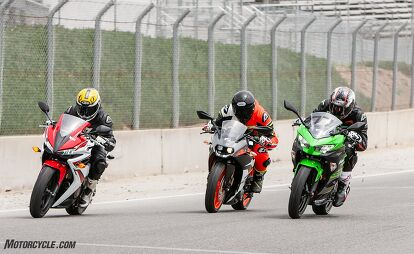

























































































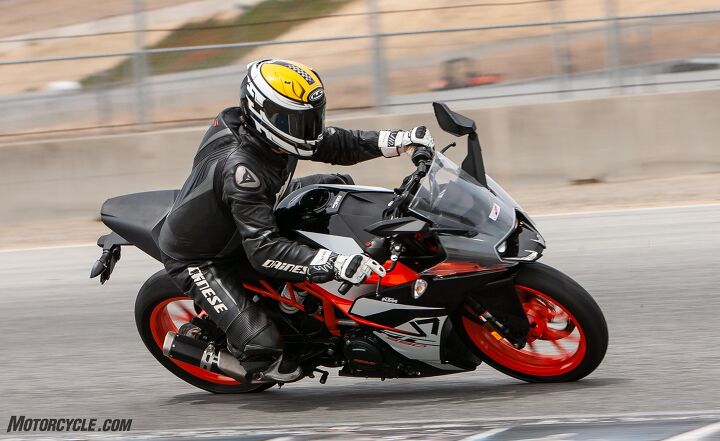















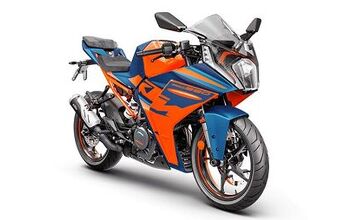








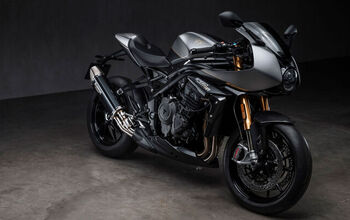




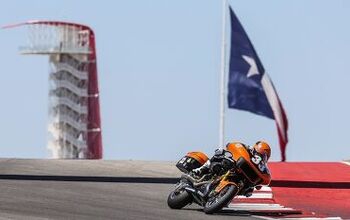
Comments
Join the conversation
Dear Kawasaki,
Put the Ninja 400 engine in the Versys 300. Don't "re tune it for torque" just stick it right in there, 12K RPM limit and all. Then sit back and sell lots of them.
Another point, looking at the Ninja's dyno chart with it's "peak and hold" power curve, there is obviously some serious ECU power restricting going on - I am sure to keep it within tiered licensing power levels. My childlike mind wants to know what an uncorked Ninja with a can and ECU reflash can do.
Funny thing about all this small bike displacement creep is we are slowly working our way back to the Ninja 500, which was truly a classic bike in it's time. 500cc. done right, can be pretty cool.
I would love to see a old school Honda CB-1 (NC27) in the mix to see how it compares. I love the 13500 Redline and how smooth it is.